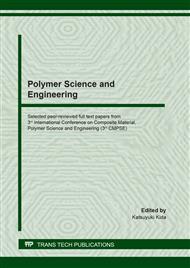[1]
I. Mundi, Malaysia palm oil production by year, in, (2017).
Google Scholar
[2]
M.J. Iskandar, A. Baharum, F.H. Anuar, R. Othaman, Palm oil industry in South East Asia and the effluent treatment technology—A review, Environmental technology & innovation, 9 (2018) 169-185.
DOI: 10.1016/j.eti.2017.11.003
Google Scholar
[3]
U. Wangrakdiskul, P. Khonkaew, T. Wongchareonsin, Use of the spent bleaching earth from palm oil industry in non fired wall tiles, in: The 3rd International Symposium on the Fusion Technologies, (2014).
DOI: 10.17703/ijact.2015.3.2.15
Google Scholar
[4]
A. Beshara, C.R. Cheeseman, Reuse of spent bleaching earth by polymerisation of residual organics, Waste management, 34 (2014) 1770-1774.
DOI: 10.1016/j.wasman.2014.04.021
Google Scholar
[5]
H.A. Abdulbari, N. Zuhan, Grease Formulation from Palm Oil Industry Wastes, Waste and biomass valorization, 9 (2018) 2447-2457.
DOI: 10.1007/s12649-018-0237-6
Google Scholar
[6]
A. MALITHONG, C. PIPUTSITEE, E. SAROBOL, K. SRIROTH, Zero Waste Management to Increase Efficiency in Palm Oil Production and Processing for Food Security in Thailand, Walailak Journal of Science and Technology (WJST), 14 (2016) 589-596.
Google Scholar
[7]
R. Dungani, P. Aditiawati, S. Aprilia, K. Yuniarti, T. Karliati, I. Suwandhi, I. Sumardi, Biomaterial from Oil Palm Waste: Properties, Characterization and Applications, Palm Oil, (2018) 31.
DOI: 10.5772/intechopen.76412
Google Scholar
[8]
B.S. Thomas, S. Kumar, H.S. Arel, Sustainable concrete containing palm oil fuel ash as a supplementary cementitious material–A review, Renewable and Sustainable Energy Reviews, 80 (2017) 550-561.
DOI: 10.1016/j.rser.2017.05.128
Google Scholar
[9]
D. Eliche-Quesada, F. Corpas-Iglesias, Utilisation of spent filtration earth or spent bleaching earth from the oil refinery industry in clay products, Ceramics International, 40 (2014) 16677-16687.
DOI: 10.1016/j.ceramint.2014.08.030
Google Scholar
[10]
M.E. Rahman, A.L. Boon, A.S. Muntohar, M.N.H. Tanim, V. Pakrashi, Performance of masonry blocks incorporating palm oil fuel ash, Journal of cleaner production, 78 (2014) 195-201.
DOI: 10.1016/j.jclepro.2014.04.067
Google Scholar
[11]
P. Lertwattanaruk, A. Suntijitto, Properties of natural fiber cement materials containing coconut coir and oil palm fibers for residential building applications, Construction and Building Materials, 94 (2015) 664-669.
DOI: 10.1016/j.conbuildmat.2015.07.154
Google Scholar
[12]
P. Darsana, R. Abraham, A. Joseph, A. Jasheela, P. Binuraj, J. Sarma, Development of coir-fibre cement composite roofing tiles, Procedia Technology, 24 (2016) 169-178.
DOI: 10.1016/j.protcy.2016.05.024
Google Scholar
[13]
U. Wangrakdiskul, R. Neamlut, Reutilizing Sediment Soil Wastes from Water Supply Treatment Process as Replacement Materials of Non-Fired Wall Tiles, in: Materials Science Forum, Trans Tech Publ, 2018, pp.303-310.
DOI: 10.4028/www.scientific.net/msf.917.303
Google Scholar
[14]
N. Kummoonin, M. Jaimasith, W. Thiemsorn, Fabrication of ceramic floor tiles from industrial wastes, Suranaree J. Sci. Technol, 21 (2014) 65-77.
Google Scholar
[15]
U. Wangrakdiskul, W. Loetchantharangkun, Utlizaing green glass cullet, local ball clay and white clay for producing light greenish brown color wall tile, (2019) 39-47.
DOI: 10.33422/ejest.2019.08.14
Google Scholar
[16]
N. Pangsang, U. Rattanapan, A. Thanapimmetha, P. Srinopphakhun, C.-G. Liu, X.-Q. Zhao, F.-W. Bai, C. Sakdaronnarong, Chemical-free fractionation of palm empty fruit bunch and palm fiber by hot-compressed water technique for ethanol production, Energy Reports, 5 (2019) 337-348.
DOI: 10.1016/j.egyr.2019.02.008
Google Scholar
[17]
D. Njoya, A. Elimbi, D. Fouejio, M. Hajjaji, Effects of two mixtures of kaolin-talc-bauxite and firing temperatures on the characteristics of cordierite-based ceramics, Journal of Building Engineering, 8 (2016) 99-106.
DOI: 10.1016/j.jobe.2016.10.004
Google Scholar
[18]
F. Siqueira, J. Holanda, Application of grits waste as a renewable carbonate material in manufacturing wall tiles, Ceramics International, 44 (2018) 19576-19582.
DOI: 10.1016/j.ceramint.2018.07.203
Google Scholar


